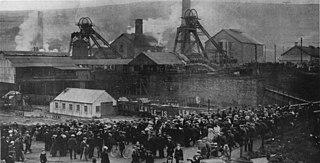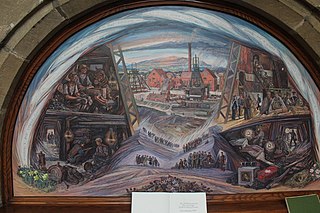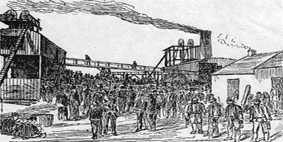A mining accident is an accident that occurs during the process of mining minerals or metals. Thousands of miners die from mining accidents each year, especially from underground coal mining, although accidents also occur in hard rock mining. Coal mining is considered much more hazardous than hard rock mining due to flat-lying rock strata, generally incompetent rock, the presence of methane gas, and coal dust. Most of the deaths these days occur in developing countries, and rural parts of developed countries where safety measures are not practiced as fully. A mining disaster is an incident where there are five or more fatalities.
Afterdamp is the toxic mixture of gases left in a mine following an explosion caused by methane-rich firedamp, which itself can initiate a much larger explosion of coal dust. The term is etymologically and practically related to other terms for underground mine gases—such as firedamp, white damp, and black damp, with afterdamp being composed, rather, primarily by carbon dioxide, carbon monoxide and nitrogen, with highly toxic stinkdamp-constituent hydrogen sulfide possibly also present. However, the high content of carbon monoxide is the component that kills, preferentially combining with haemoglobin in the blood and thus depriving victims of oxygen. Globally, afterdamp has caused many of the casualties in disasters of pit coalfields, including British, such as the Senghenydd colliery disaster. Such disasters continue to afflict working mines, for instance in mainland China.

The Senghenydd colliery disaster, also known as the Senghenydd explosion, occurred at the Universal Colliery in Senghenydd, near Caerphilly, Glamorgan, Wales, on 14 October 1913. The explosion, which killed 439 miners and a rescuer, is the worst mining accident in the United Kingdom. Universal Colliery, on the South Wales Coalfield, extracted steam coal, which was much in demand. Some of the region's coal seams contained high quantities of firedamp, a highly explosive gas consisting of methane and hydrogen.

The Gresford disaster occurred on 22 September 1934 at Gresford Colliery, near Wrexham, Denbighshire, when an explosion and underground fire killed 266 men. Gresford is one of Britain's worst coal mining disasters: a controversial inquiry into the disaster did not conclusively identify a cause, though evidence suggested that failures in safety procedures and poor mine management were contributory factors. Further public controversy was caused by the decision to seal the colliery's damaged sections permanently, meaning that only eleven of those who died were recovered.
Clifton Hall Colliery was one of two coal mines in Clifton on the Manchester Coalfield, historically in Lancashire which was incorporated into the City of Salford in Greater Manchester, England in 1974. Clifton Hall was notorious for an explosion in 1885 which killed around 178 men and boys.
Halmer End is a small village in the Borough of Newcastle-under-Lyme in Staffordshire, neighbouring the small hamlet of Alsagers Bank and the larger village of Audley.
The South Yorkshire Coalfield is so named from its position within Yorkshire. It covers most of South Yorkshire, West Yorkshire and a small part of North Yorkshire. The exposed coalfield outcrops in the Pennine foothills and dips under Permian rocks in the east. Its most famous coal seam is the Barnsley Bed. Coal has been mined from shallow seams and outcrops since medieval times and possibly earlier.

The North Staffordshire Coalfield was a coalfield in Staffordshire, England, with an area of nearly 100 square miles (260 km2), virtually all of it within the city of Stoke on Trent and the borough of Newcastle-under-Lyme, apart from three smaller coalfields, Shaffalong and Goldsitch Moss Coalfields near Leek and the Cheadle Coalfield. Coal mining in North Staffordshire began early in the 13th century, but the industry grew during the Industrial Revolution when coal mined in North Staffordshire was used in the local Potteries ceramics and iron industry.
The West Stanley Pit disasters refers to two explosions at the West Stanley colliery. West Stanley colliery was a coal mine near Stanley, with the mine opening in 1832 and closing in 1936. Over the years several seams were worked through four shafts: Kettledrum pit, Lamp pit, Mary pit and New pit. In 1882 an underground explosion killed 13 men and in 1909 another explosion killed 168 men.

Gresford Colliery was a coal mine located a mile from the North Wales village of Gresford, near Wrexham.

Six Bells Colliery was a colliery located in Six Bells, Abertillery, Gwent, Wales. On 28 June 1960 it was the site of an underground explosion which killed 45 of the 48 miners working in that part of the mine. It is now the site of the artistically acclaimed Guardian memorial to those events, designed by Sebastian Boyesen; although the memorial primarily commemorates those who died at Six Bells, it is dedicated to all mining communities wherever they may be.
The Holditch Colliery disaster was a coal mining accident on 2 July 1937, in Chesterton, Staffordshire, England, in which 30 men died and eight were injured. It was caused by a fire and subsequent explosions, and was exacerbated by a decision from management to risk the lives of mine workers to try to save the coal seam.

The Lancashire Coalfield in North West England was an important British coalfield. Its coal seams were formed from the vegetation of tropical swampy forests in the Carboniferous period over 300 million years ago.
Tyldesley Coal Company was a coal mining company formed in 1870 in Tyldesley, on the Manchester Coalfield in the historic county of Lancashire, England that had its origins in Yew Tree Colliery, the location for a mining disaster that killed 25 men and boys in 1858.

Bradford Colliery was a coal mine in Bradford, Manchester, England. Although part of the Manchester Coalfield, the seams of the Bradford Coalfield correspond more closely to those of the Oldham Coalfield. The Bradford Coalfield is crossed by a number of fault lines, principally the Bradford Fault, which was reactivated by mining activity in the mid-1960s.

The Maypole Colliery disaster was a mining accident on 18 August 1908, when an underground explosion occurred at the Maypole Colliery, in Abram, near Wigan, then in the historic county of Lancashire, in North West England. The final death toll was 76.
The Sneyd Colliery Disaster was a coal mining accident on 1 January 1942 in Burslem in the English city of Stoke-on-Trent. An underground explosion occurred at 7:50 am, caused by sparks from wagons underground igniting coal dust. A total of 57 men and boys died.
Hapton Valley Colliery was a coal mine on the edge of Hapton near Burnley in Lancashire, England. Its first shafts were sunk in the early 1850s and it had a life of almost 130 years, surviving to be the last deep mine operating on the Burnley Coalfield.








